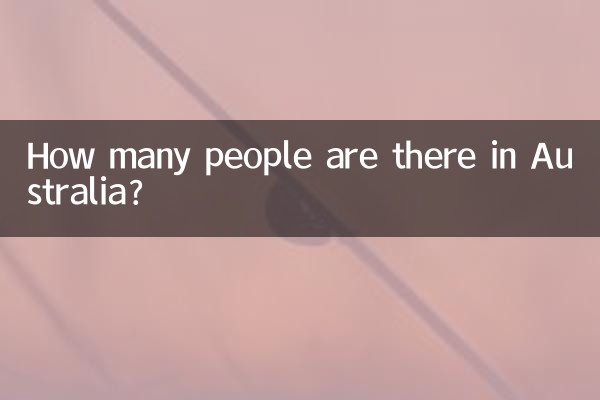How many people are there in Australia? 2023 population data and hot spot analysis
As an economically developed country in the southern hemisphere, Australia's population changes have always attracted much attention. This article will combine the latest data and recent hot topics to provide you with a comprehensive analysis of Australia's population status.
1. Australia’s latest demographic data

| indicator | data | Statistics time |
|---|---|---|
| total population | 26,473,055 people | December 2023 |
| population growth rate | 1.4% | 2022-2023 |
| population density | 3.4 people/square kilometer | 2023 |
| Male proportion | 49.3% | 2023 |
| Female ratio | 50.7% | 2023 |
| Median age | 38.5 years old | 2023 |
| Proportion of population born overseas | 29.1% | 2023 |
2. Population distribution characteristics
Australia's population is extremely unevenly distributed, with about 90% of the population concentrated in coastal areas. The following are population data for major cities:
| city | population | National proportion |
|---|---|---|
| sydney | 5,367,206 | 20.3% |
| Melbourne | 5,207,145 | 19.7% |
| brisbane | 2,628,083 | 9.9% |
| Perth | 2,192,229 | 8.3% |
| adelaide | 1,376,601 | 5.2% |
3. Recent hot topics in population
1.Immigration policy adjustments: The Australian government recently announced that it will tighten immigration policies and plans to reduce the number of immigrants by 50% in the next two years. This policy sparked widespread discussion.
2.housing crisis: Rapid population growth has caused housing prices in major cities to continue to rise, with the median house price in Sydney and Melbourne exceeding A$1 million.
3.Aboriginal population growth: Statistics in 2023 show that the Aboriginal and Torres Strait Islander population has reached 980,000, accounting for 3.8% of the total population, with a growth rate higher than the national average.
4.aging problem: The proportion of the population over 65 years old has reached 17% and is expected to rise to 23% by 2060, putting pension and medical systems under pressure.
4. Population Growth Forecast
| Year | Projected population | growth rate |
|---|---|---|
| 2025 | 27,200,000 | 1.3% |
| 2030 | 28,500,000 | 1.2% |
| 2040 | 30,800,000 | 0.9% |
| 2050 | 32,900,000 | 0.7% |
5. International Comparison
Australia ranks 55th in the world in terms of population and has a similar population size to the following countries:
| country | population | Compare with Australia |
|---|---|---|
| malaysia | 33,573,000 | 27% more |
| saudi arabia | 36,408,000 | 38% more |
| Canada | 38,781,000 | 46% more |
| Poland | 37,765,000 | 43% more |
6. Expert opinions
Demographers point out that the main challenge facing Australia is how to balance population growth and sustainable development. Immigration is needed to fill labor gaps on the one hand, and to address infrastructure and housing pressures on the other. Future policies will focus more on the quality rather than the quantity of skilled immigrants.
Overall, Australia's current population is about 26.5 million, maintaining a relatively rapid growth rate among developed countries. Demographic structural changes and immigration policy adjustments will be the focus of future attention.

check the details

check the details